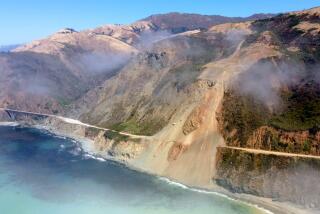Relief Rises With Stream Repairs
- Share via
San Juan Creek once again is nothing more than a trickle, a comforting fact for Roger York and his neighbors in San Juan Capistrano.
Last month, after days of rain, the swollen creek chewed away its concrete embankment and forced about 4,000 residents to leave their homes out of fear that the saturated soil on the bank would give way and allow the creek to crest and flood homes.
“Had it rained another 12 hours, we would’ve been in trouble,” said York, who lives in the Rancho del Avion Mobile Home Park. “Usually the creek’s pretty much empty. You can walk across it 10 months out of the year.”
Now that the creek has become its more mild-mannered self again, engineers have temporarily repaired the riverbank that took the brunt of the deluge. The repair job should be done by the weekend, said Jay Field, spokesman for the Army Corps of Engineers.
The work comes as other points damaged in January’s rains -- Ortega Highway and San Clemente’s Beachcomber Motel -- return to normal.
Ortega Highway, the winding mountain road that connects Orange and Riverside counties, reopened Jan. 28 after a 120-foot-wide sinkhole forced its closure for more than two weeks. And the Beachcomber Motel, which sits near the pier in San Clemente, is back in business after a landslide forced owners to close shop.
But repairing San Juan Creek posed a daunting task for engineers, who had to bolster a 1,400-foot stretch of the creek’s west bank -- a $3-million project that involved moving about 27,300 cubic yards of dirt, 24,500 tons of rock and 2,450 tons of aggregate material.
“The temporary get-us-through-the-winter repairs are in place,” said Bill Tidwell, the county’s operations maintenance manager.
San Juan Capistrano officials estimate that a 200- to 300-stretch of the bike trail swallowed by the creek will be restored in about a month, though the fix will be a temporary one.
Sleep hasn’t been easy to come by along the creek where crews have worked around the clock. Still, the sounds of heavy machinery are music to Maureen Thompson’s ears.
“I’m just very grateful for all the noise” and the effort, said Thompson, who lives with her husband, Mike, and their two grown children at the creek’s bend, about a mile upstream from Doheny State Beach.
The city sent a Jan. 27 letter apologizing to residents for the noise and inconvenience.
“I don’t even understand why they sent it,” said Mike Thompson. “Anyone who resents the noise needs to think twice next time it rains.”
Permanent repairs to the creek’s bank must take place in the drier summer months, when the corps will return to replace the rocks and boulders with concrete, said Herb Nakasone, the county’s director of public works.
That 30- to 45-day project will cost an additional $8 million, he said.
But additional long-term improvements, costing as much as $50 million, will be necessary to prevent fast-moving, heavy runoff from again eroding the earthen creek’s bottom and sides and undermining the concrete panels, Nakasone said.
Three possible solutions include lining the entire river bed with concrete; constructing steps or grade stabilizers in intervals along the river to flatten the slope, slow down the water flow and prevent erosion; or building a dam or containment structure to collect and slowly release water upstream.
Mike Thompson, who has lived along the creek since 1977, remembers when the stream bed used to dry up during summer.
“It runs year round now,” said Thompson, who attributed increased runoff to the surge in development in the hills above San Juan Capistrano.
“When it comes right down to it, there’s only so many things you can do to contain Mother Nature. Sooner or later she’s going to have her way,” he said.
More to Read
Sign up for Essential California
The most important California stories and recommendations in your inbox every morning.
You may occasionally receive promotional content from the Los Angeles Times.













